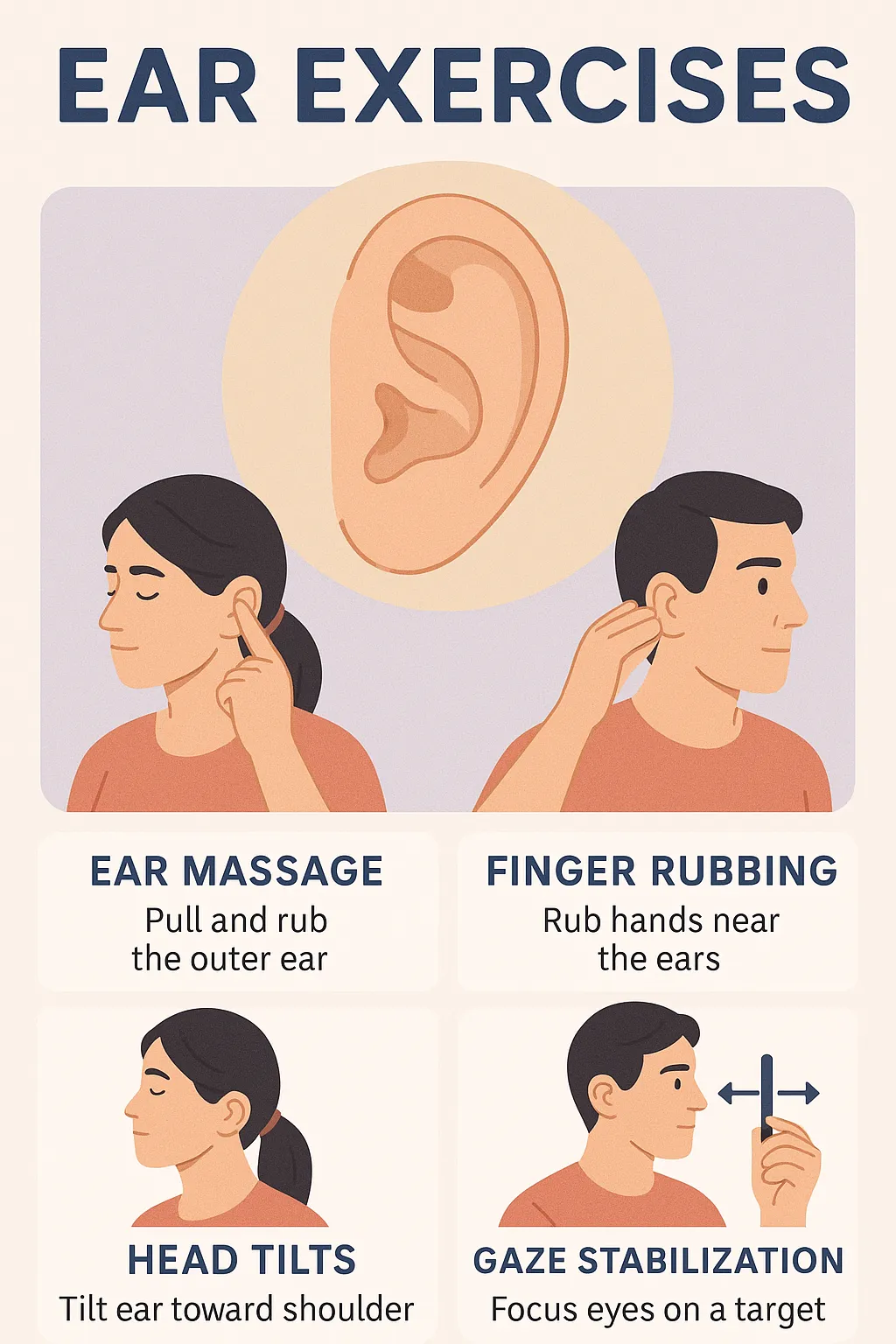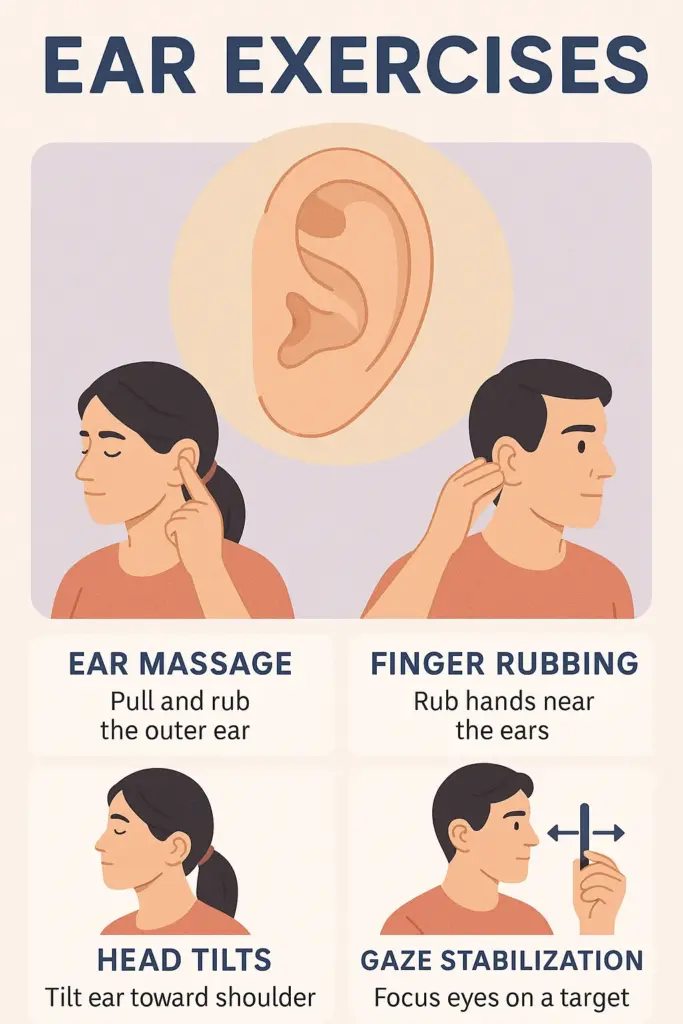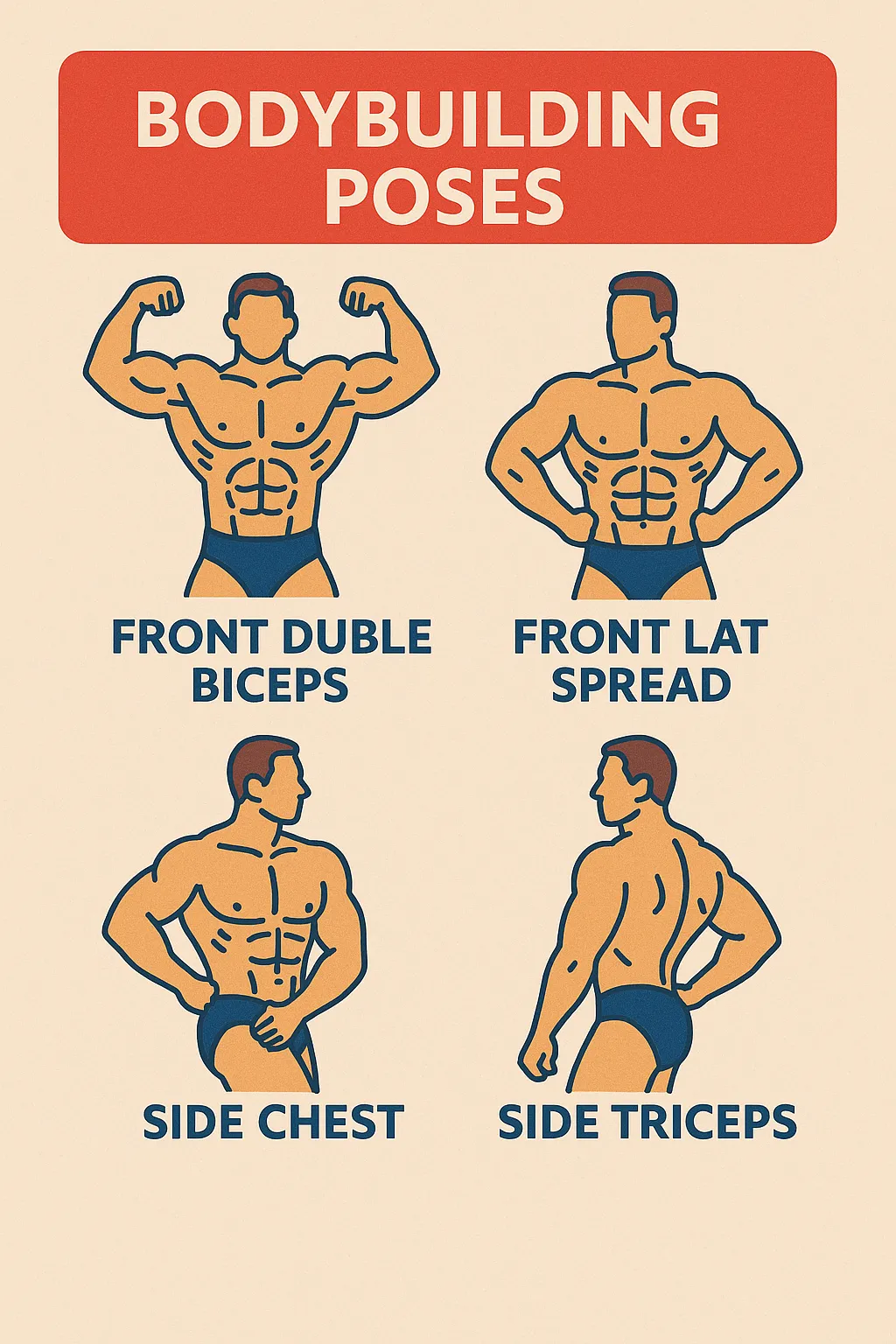Ear care is one aspect of physical health and wellness that gets overlooked. While most of us have heard of eye exercises or stretching routines for the body, few consider that our ears, important organs not only for hearing but also for balance, can benefit from focused workouts, too.

From auditory perception improvements to balance issues, or maybe you just want to keep those ears on top of their game, ear exercises can be a powerful tool in your daily wellness.
In this blog post, we’ll discuss the idea of ear exercises, the science behind them, the different types you can do, and how they support people of all ages and needs.
Table of Contents
1. What Are Ear Exercises?
2. How the Ear Works: The Science Behind It
3. Benefits of Ear Exercises
4. Types of Ear Exercises
• Hearing Exercises
• Balance and Vestibular Exercises
• Tinnitus Relief Exercises
• Yoga, Breathing and Exercise in General
• Activities to Develop Auditory Skills in Children
• Ear Training for Music and Language
5. Safety Considerations
6. 3 Tips on How to Effectively Apply Ear Exercises
7. Conclusion
What Are Ear Exercises?
Ear exercises can refer to certain techniques or practices intended to help improve auditory processing, boost hearing ability or even help with maintaining balance in the inner ear, as well as relieving symptoms like tinnitus.
Such exercises may involve physical, auditory, or even cognitive movements, and they are generally advised for people who are recovering from hearing loss, people who have vertigo, or anyone who wants to improve their listening skills.
Ear exercises won’t cure any serious conditions, but they can be a supplement to therapy, support auditory health, and even enhance cognitive functions associated with hearing.
How the Ear Works: The Science Behind It
The Ear:
The ear consists of three parts: the outer, middle, and inner ear.
• Outer Ear: Collects sound waves and directs them inside.
• Middle Ear: Transmits these vibrations through the ossicles (small bones).
• Inner Ear: Contains the cochlea for auditory and the vestibular for gravitational sense.
The cochlea translates sound vibrations into neural signals that the brain interprets. The vestibular system, which includes semicircular canals, also functions in balance and spatial orientation.
The auditory system can be challenged by age-related hearing loss (presbycusis), exposure to loud sounds, or inner ear infections over time. Just as physical exercise helps keep muscles strong, certain exercises can help your ears and the related neural networks stay sharp.
Benefits of Ear Exercises
Adding ear work to an existing routine provides many benefits:
• Improved hearing acuity
• Enhanced sound localisation
• Less three-dimensional noise distraction
• Relief from tinnitus symptoms
• Better balance and coordination
• Improved language acquisition and musical ability
• Enhanced auditory memory and cognition
Whether you’re an older adult, a student, a musician, or someone recovering from inner ear disorders, ear exercises can have both specific and general benefits.
Types of Ear Exercises
Hearing Exercises
Develop your listening skills and auditory focus. These exercises engage cognition with sounds.
1. Exercises for Discrimination of Sound
• Utilize audio apps or recordings that play similar-sounding syllables (e.g., “ba” vs. “pa”).
• Concentrate on differentiating them.
• Sharpens the brain’s ability to distinguish subtle sound differences.
2. Background Noise Training
• Play a low-level noise while listening to a speaker or podcast.
• Train your brain to focus on relevant sounds in noisy environments.
3. Directional Hearing Exercises
• Sit with a blindfold while someone claps or plays sounds from different angles.
• Guess the direction.
• Improves sound orientation.
Balance and Vestibular Exercises
Inner ear balance training for people with dizziness or vertigo. Often prescribed by physical therapists.
1. Gaze Stabilization (Vestibulo-Ocular Reflex Training)
• Move your head side-to-side while keeping your eyes on a fixed target.
• Improves timing between head and eye movements.
2. Brandt-Daroff Exercises
• Sit up, then rapidly fall to one side with arms raised at a 45° angle.
• Hold 30 seconds, then sit up and repeat on the other side.
• Helps relieve benign paroxysmal positional vertigo (BPPV).
3. Walking with Head Turns
• Walk straight while turning your head left and right.
• Builds vestibular compensation and confidence in balance.
Tinnitus Relief Exercises
Tinnitus is the ringing or buzzing in the ears. No cure exists, but exercises can help manage it.
1. Progressive Muscle Relaxation (PMR)
• Tense and relax muscle groups from head to toe.
• Reduces stress that can worsen tinnitus.
2. Breathing and Mindfulness Exercises
• Spend 5–10 minutes daily doing deep belly breathing.
• Reduces tension and shifts perception of tinnitus.
3. Sound Therapy
• Use ambient or white noise to reduce the brain’s focus on tinnitus.
• Apps and hearing aids often include sound generators.
Yoga and Breathing-Based Exercises
Physical postures and controlled breathing for ear care.
1. Bhramari Pranayama (Humming Bee Breath)
• Deep breath in, hum softly out while pressing fingers to ears.
• Calms the mind, aids in focus and tinnitus relief.
2. Neck and Shoulder Stretches
• Relieve tension that may affect ear pressure.
• Boost circulation in the ear region.
Activities to Promote Auditory Development in Infants and Young Children
1. Rhyming Games
• Builds phonemic awareness, a key pre-reading skill.
2. Listening to Stories Repeatedly
• Enhances comprehension and retention.
3. Sound Hunt
• Children identify sounds from their environment (birds, clocks, footsteps).
• Enhances listening discrimination and attention.
Ear Training for Music and Language
Musicians and polyglots can sharpen their hearing and brain function with these:
1. Interval Recognition
• Recognise pitch distances between musical notes.
• Trains the ear for tone and pitch.
2. Dictation Practice
• Transcribe music or speech from audio.
• Enhances auditory memory.
3. Accent and Intonation Mimicry
• Mimic foreign speech and rhythms.
• Boosts language and accent learning.
These exercises promote neural plasticity, the brain’s ability to grow and rewire through practice.
Safety Considerations
Ear exercises are generally safe, but:
• If you have ongoing hearing loss, vertigo, or ear infections, consult a healthcare provider first.
• Avoid overusing earbuds or headphones, especially at high volumes.
• Stop any exercise that causes dizziness, nausea, or discomfort.
• Never insert objects into your ears during exercises.
• Use caution with pressure during yoga or breath work if you have sinus or ear issues.
3 Tips on How to Effectively Apply Ear Exercises
1. Be consistent: Practice every day to see results.
2. Tally progress: Track improvements in focus, clarity, or balance.
3. Mix it up: Rotate exercise types to stay engaged.
Also:
• Maintain good nutrition, hydration, and sleep.
• Use tech tools like SoundGym, Tinnitus Notch, or Headspace to support your routine.
Final Thoughts
Ear exercises are a lesser-known yet powerful way to boost auditory processing, maintain balance, and support brain function. Whether you’re dealing with hearing issues, aiming to improve focus, or simply want to care for your ears, there’s an exercise for that.
Start small. Practice consistently. And most importantly: Listen — not just with your ears, but with intention.
Your ears are portals to connection, communication, and cognition. Take a moment to acknowledge them as they deserve.







